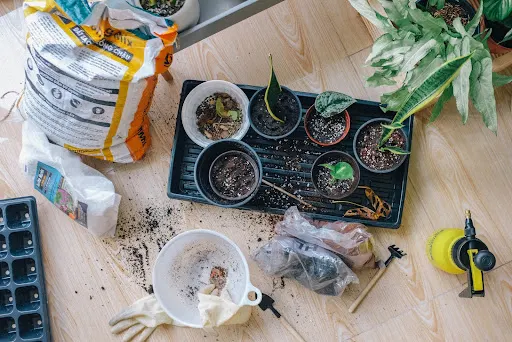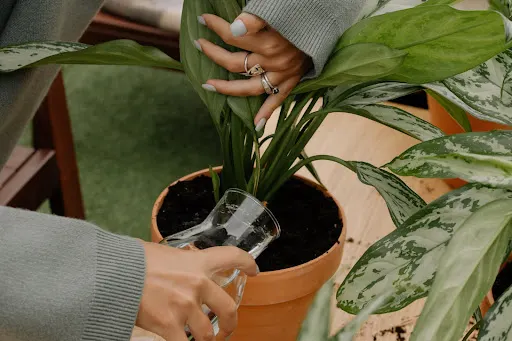October 26, 2021
How to Propagate Plants From Cuttings in 3 Steps
When it comes to propagation of plants, most people haven’t attempted it because they are afraid it is a difficult, lengthy, and arduous process. But did you know it is actually a pretty manageable process that can be done in 3 easy steps? Yes, it’s true! Though each plant has specific properties and calls for their own propagation needs, you can easily propagate the plants that you already own, multiplying them to add to your very own plant collection, or to share the green love and give them as gifts for close friends and family. And it can happen all in a few easy steps. Plus, you probably already have all the supplies you need to make your propagation dreams a reality. So, what are you waiting for? Keep reading and let’s get to figuring out how to propagate cuttings to grow your garden and fill it with more beautiful plant babies.
Step 1: Make the Cut
In order to start the propagation process, you must begin with cutting the original plant. So, can you just cut the plant from anywhere, stick that piece in soil or water, and hope it works? Though that would make things extremely simple, you do want to use some foresight, intention, and planning when it comes to where to cut a plant to propagate.
Plant Cutting Methods
You are probably thinking where do I cut the plant for propagation and how do I propagate cuttings? Well, there are a few different methods you can use in order to cut the plant properly, and to get it to take in the soil or in water, and they are: stem cutting, leaf cutting, leaf with petiole cutting, leaf section cutting, and root cutting. Some plants will do better with a specific cutting method, and others will flourish with a separate method. It is imperative for your plant’s propagation success to know which method is most effective before you start cutting your plant. So, be sure to read each method and decide which will work for the plant you are hoping to propagate.
Stem cutting
Stem cutting will work for those multi-stemmed houseplants like pothos, tradescantia, and philodendron. Yes, those mood-boosting houseplants that you already have at home can be stem cut and multiplied. In order to have a successful stem cutting plant propagation, you will need to cut off a 3-5-inch stem from a top or side branch of your plant. Snip right below where the leaf meets the stem (also known as the node), and then pull off the lower leaves. Once you have snipped the stem and removed the leaves, you can dip the cut end in a rooting hormone to help it on its propagation journey.
Leaf-cutting
Whole leaf cutting is a propagation method that works best for succulents, air plants, and snake plants. So, how do you propagate succulents, air plants, and snake plants with leaf-cutting? To start with the leaf-cutting propagation process, you will of course need to pick a plant. If you aren’t wanting to cut the leaves of your current plants then you can always buy plants online or specifically order succulent leaves to use. If you are taking from your succulent that you have finally got to flourish from referencing our succulent care guides, then instead of cutting, you will gently twist off a leaf from the stem. This will give you a good piece of the succulent to propagate. If you are using the leaf-cutting method with the snake plant, you will want to cut the base of the leaf and then cut that into smaller 2-3 -inch sections. Once the cutting has been done, you will want to place the leaf cuttings in a safe spot to allow the edges to dry out for about 1-3 days.
Leaf with petiole
To have propagation success with a leaf with a petiole, you will want to choose a plant like a peperomia, Swedish ivy, kalanchoe, or a different one with petioles (stalks that join the leaves to the stem). Once you have the plant in front of you, you want to try to find a healthy leaf, one with just about an inch of petiole. Cut the petiole with sharp scissors or a razor blade for a complete and clean cut.
Leaf sections
Though using leaf sections isn’t the most effective way of growing plants from cuttings, with the proper care and attention, leaf sections can be cut and used for plant propagation from plants such as a streptocarpus, African violet, and a begonia rex. Using leaf sections is very similar to using general leaf-cuttings. You will use a section of the leaf, care for it, and hopefully it will properly propagate and provide you with a new plant.
Root cuttings
Root cutting propagation is best used for plants that are getting too large for their pots, and you need to give them some more space. Root division will require you to divide the entire plant into smaller pieces, but you must keep the root intact. This should really only be done if each section of the plant has its own root ball/root system. If not, they run the risk of drying out and no longer being able to receive nutrients from the root system. So, in order to do this properly, you need to pull the plant from its pot and expose those roots. Gently pull the roots apart and separate the plants. Then they will be able to be put in water or directly in the soil.
Step 2: Add Water
Once you have cut and prepared each plant, you will need to move onto the next step of propagation which is adding water. You will want to use bottled spring or well water for this step, as tap water can be filled with different pollutants or chemicals that can harm the plant during this period. Place the cutting into a glass vase and add water. The glass vase will allow you to see how its roots are expanding and growing, and it will make it so you are able to see when it is time to plant it in its own pot with soil. It is important to note that you should try to replace the water every few days to avoid fungal growth and to ensure you are giving your cutting a proper chance at survival. A good way to tell when to plant a propagated plant that has had its start with a water vase, is when the plant shows that roots have formed from the stem cutting.
Step 3: Transfer Into Soil
Now that about 4-6 weeks have passed, the cutting has been successful and the new roots have formed and grown out, it is time to transfer your plant from the water to the soil. Take your new plant and its 1 inch or longer root system and plant it in a new pot or planter, with a healthy helping of potting soil. This will allow the plant to form its new home and grow to its full potential. Once the plant has made its new home in the pot, you want to provide it with the proper care and attention it specifically needs. So, follow its proper water schedule and light wants in order to see it flourish and one day propagate from your cutting.
Propagating Plants: Frequently Asked Questions
Can you propagate any plant?
With the right amount of time, dedication, and devotion, you can propagate any plant, but some are significantly harder than others. We suggest getting your feet wet with a few of the plants we listed above, as they are easier to manage and great beginner propagation plants. Once you get the hang of it and a feel for what is required of you for this process, you can graduate yourself onto more difficult propagation projects.
What is the best way to propagate plants?
It is hard to determine a hard and fast rule for the best way to propagate plants, because each plant does their best in different ways. Before you start cutting, snipping, or slicing any of your plants, we recommend reading the information above on which type of plants will thrive with what type of propagation. Then, once you know how to best handle the plant, you can start to cut, twist, or de-root the plant.
How do you propagate plants from cuttings?
For plant propagation from cuttings, remember that there are two ways to try and get them to regrow. You can either put them in a glass vase with water and watch their roots sprout, or you can place them in a soil that is kept moist with water until the roots form. Either way you choose, you once again want to be sure that you are doing what is best for that specific plant cutting.
What plant cuttings can be rooted in water?
Most plant cuttings can be rooted in water, but there are some that will thrive in that condition more than others. Plants that originate from more swampy species of plants will really flourish right away in a water vase as opposed to a soil pot. Plants like pothos plants, philodendrons, monsteras, and ZZ plants will do very well in water, while plants like succulents, air plants, and snake plants will be happier in soil.
Wrapping Up
The most important thing to remember when it comes to propagating plants is, similar to when it comes to watering and sun exposure, each plant has its own wants and needs. Be sure to cut, water, and plant your propagations according to their needs as best as you can. If you do, you will see the results you want and will have plenty more houseplants to add to your collection. And remember, when it comes to how to grow a plant from cuttings, when to pot propagated plants, how to care for your plants, and buying houseplants, succulents, and more, FTD has you covered. From our helpful blogs, to our easy-to-navigate shopping site, we have what you need to take care of all your plant and flower needs.




